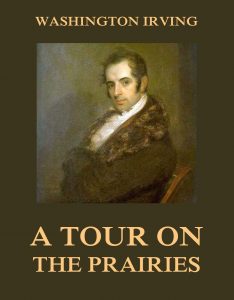A Tour on the Prairies – Washington Irving
The productions of Washington Irving are deservedly held in high estimation, not so much, perhaps, for their intrinsic merits as literary compositions, although in this respect they hold no mean position, as for the inimitable tracings of adventurous life which they display through all their gradations and variety, and for the interest they keep alive in the reader, without outraging nature. Several hundred miles beyond the Mississippi extended a vast tract of uninhabited country, where there is neither to be seen the log-house of the white man nor the wigwam of the Indian. It consisted of large grassy plains, interspersed with forests and groves, and watered by the Arkansas, the Grand Canadian, the Red River, and all their tributary streams. Over these fertile and verdant wastes roamed the elk, the buffalo, and the wild horse, in all their native freedom—and these were, in fact, the hunting-grounds of the various inhabitants of the Far West. Thither repaired the Osage, the Creek, the Delaware, and other tribes, that had linked themselves with civilization, and lived within the vicinity of the white settlements; and here resorted also the Pawnees, the Comanches, and a variety of fierce and as yet independent rovers, the nomades of the prairies, or the inhabitants of the skirts of the Rocky Mountains.
Format: Paperback.
A Tour on the Prairies.
ISBN: 9783849673406.
Available at amazon.com and other venues.
Biography of Washington Irving (from Wikipedia):
Washington Irving (April 3, 1783 – November 28, 1859) was an American short story writer, essayist, biographer, historian, and diplomat of the early 19th century. He is best known for his short stories “Rip Van Winkle” (1819) and “The Legend of Sleepy Hollow” (1820), both of which appear in his book The Sketch Book of Geoffrey Crayon, Gent. His historical works include biographies of George Washington, Oliver Goldsmith, and Muhammad, and several histories of 15th-century Spain dealing with subjects such as Christopher Columbus, the Moors and the Alhambra. Irving served as the U.S. ambassador to Spain from 1842 to 1846.
He made his literary debut in 1802 with a series of observational letters to the Morning Chronicle, written under the pseudonym Jonathan Oldstyle. After moving to England for the family business in 1815, he achieved international fame with the publication of The Sketch Book of Geoffrey Crayon, Gent. in 1819–20. He continued to publish regularly—and almost always successfully—throughout his life, and just eight months before his death (at age 76, in Tarrytown, New York), completed a five-volume biography of George Washington.
Irving, along with James Fenimore Cooper, was among the first American writers to earn acclaim in Europe, and Irving encouraged American authors such as Nathaniel Hawthorne, Herman Melville, Henry Wadsworth Longfellow, and Edgar Allan Poe. Irving was also admired by some European writers, including Walter Scott, Lord Byron, Thomas Campbell, Francis Jeffrey, and Charles Dickens. As United States first genuine internationally best-selling author, Irving advocated for writing as a legitimate profession and argued for stronger laws to protect American writers from copyright infringement.
(The text of the last section was taken from a Wikipedia entry and is available under the Creative Commons Attribution-ShareAlike License.)
Publisher’s Note: This book is printed and distributed by Createspace a DBA of On-Demand Publishing LLC and is typically not available anywhere else than in stores owned and operated by Amazon or Createspace.

